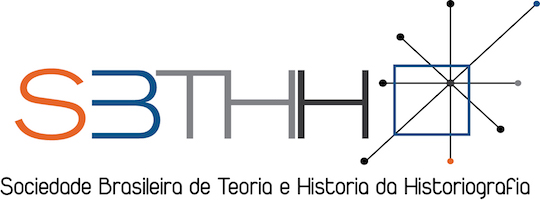Interdisciplinaridade entre as ciências históricas
definições disciplinares e princípios epistêmicos a partir de um tempo histórico profundo
DOI:
https://doi.org/10.15848/hh.v16i43.2024Palabras clave:
Tempo Histórico, Teoria e História da Historiografia, Ciências NaturaisResumen
Este trabalho consiste em um duplo esforço analítico: definicional, por um lado, quanto à unidade do campo das ciências históricas; e propositivo, por outro, buscando demonstrar vantagens epistêmicas para a historiografia
quando dimensiona seus objetos no tempo histórico profundo e faz pesquisa interdisciplinar em ciências históricas (Historiografia, Paleontologia e Geologia, entre outras) para o fornecimento de descrições mais detalhadas e novas hipóteses para explicações históricas. Tal análise está disposta em três partes: (1) a definição de ciências históricas; (2) a definição de Tempo Histórico Profundo e sua recepção nessas ciências; e (3) o estudo de três situações na
Historiografia em que é relevante a interdisciplinaridade de outras ciências históricas ou ao menos a exploração de fenômenos no passado profundo.
Descargas
Citas
BARROS, José D’Assunção. O Campo da História. Petrópolis: Vozes, 2004.
BELNAP, Nuel; MÜLLER, Thomas; PLACEK, Tomasz. Branching Space-Times: Theory and Applications. Oxford: Oxford
University Press.
BENTIVOGLIO, Júlio C. In: DROYSEN, J. G. Manual de teoria da história. Petrópolis: Vozes, 2009. p. 7-26.
BENVENISTE, Émile. Problemas de lingüistica general. v. I. Madrid: Siglo veintiuno de españa editores, 1985.
BLOCH, Marc. Apologia da História ou O Ofício do Historiador. Rio de Janeiro: Zahar, 2001 [1949].
BOWLER, Peter J. Evolution: the history of an idea. 3rd ed., completely rev. and expanded ed. Berkeley: University of California Press, 2003.
BRAUDEL, Ferdinand. A dinâmica do capitalismo. Rio de Janeiro: Rocco, 1987.
BRAUDEL, Ferdinand. Escritos sobre a história. São Paulo: Perspectiva, 2009.
CARR, Edward H. What is History? Cambridge: University of Cambridge, 1961.
CASSAB, Rita de Cassia Tardin. Objetivos e Princípios. In: CARVALHO, Ismar de Souza (org.). Paleontologia: conceitos e métodos. v. 1. Rio de Janeiro: Interciência, 2010.
CHAISSON, Eric. J. The Natural Science Underlying Big History. The Scientific World Journal, Londres, v. 2014, p. 1-41, 2014.
CHRISTIAN, David G. Maps of time: an introduction to big history. Prefácio de William McNeil ed. Berkeley, Calif London: University of California Press, 2011.
COLLADO-RUANO, Javier. Co-evolution in Big History: A Transdisciplinary and Biomimetic Approach to the Sustainable Development Goals. Social Evolution & History, Vologrado, v. 17, p. 27-41, 2018.
COSTA, Vítor M. Necessidade e possibilidade nas ciências históricas: Resultados semânticos de uma tradução modal
contradiodoreana e de uma lógica temporal occasmista para o passado. Princípios: Revista de Filosofia, Natal, v. 26, n. 51, p. 235-256, 2019.
CROSBY, Alfred. W. Imperialismo ecológico: a expansão biológica na Europa 900-1900. São Paulo: Companhia de Bolso, 2011 [1986].
CRUTZEN, Paul; STOERMER, Eugene F. The ‘Anthropocene’. Global Change Newsletter, [s.l.], v. 41, p. 17-18, 2000.
CURRIE, Adrian. Narratives, mechanisms and progress in historical science. Synthese, [s.l.] v. 191, n. 6, p. 1163-1183, 2014.
CURRIE, Adrian. Scientific Knowledge and the Deep Past: history matters. Cambridge: Cambridge University Press, 2019.
DANTO, Arthur. Narration and knowledge: including the integral text of Analytical philosophy of history. New York:
Columbia University Press, 2007.
DAWKINS, Richard. A grande história da evolução: Na trilha dos nossos ancestrais. São Paulo: Companhia das Letras, 2009.
DIAMOND, Jared M. Guns, germs, and steel: the fates of human societies. 20th Anniversary edition. New York: Norton, 2017 [1997].
DROYSEN, Johann G. Histórica: Lecciones sobre la Enciclopedia y metodologia de la historia. Barcelona: Editorial Alfa, 1983.
DUTRA, Luiz Henrique de Araújo. Introdução a Teoria da Ciência. Florianópolis: Editora UFSC, 2009.
EARLE, Timothy; GAMBLE, Clive; POINAR, Hendrik. Migration. In: SHRYOCK, Andrew.; SMAIL, Daniel L.; EARLE, T. K (orgs.). Deep history: the architecture of past and present. Berkeley: University of California Press, 2011.
FALES, Walter. Historical Facts. The Journal of Philosophy, Nova York, v. 48, n. 4, p. 85-94, 1951.
GALLIE, Walter. B. Explicações em História e as Ciências Genéticas. In: GARDINER, Patrick (org.). Teorias da História.
Lisboa: Fundação Calouste Gulbenkian, 1964 [1955], p. 472-493.
GERIC, Michelle. Tennyson’s “Maud” (1855) and the “unmeaning of names’: Geology, Language Theory, and Dialogics. Victorian Poetry, [s.l.], v. 51, n. 1, 2013, p. 37-62.
GOMBRICH, Ernest H. A História da Arte. Rio de Janeiro: Editora Guanabara S.A., 1988.
GOULD, Stephen J. Time’s arrow, time’s cycle: myth and metaphor in the discovery of geological time. Massachusetts: Harvard University Press, 2007.
GORANKO, Valentin; RUMBERG, Antlje. “Temporal Logic”. In: ZALTA, Edward N. (org.). Stanford Encyclopedia of Philosophy, [s.l.], Center for the Study of Language and Information (CSLI), 2023.
HAWKES, Christopher. Wenner-Gren Foundation Supper Conference: Archeological Theory and Method: Some Suggestions from the Old World. American anthropologist, [s.l.], v. 56, n. 2, p. 155-168, 1954.
KARSTENS, Kim. Seeking Kosmos. Earth and Mind: the blog, [s.l.], 18, nov., 2011. Disponível em: https://serc.carleton.edu/earthandmind/posts/cosmos.html. Acesso em: 22 nov. 2023.
KUHN, Thomas S. A estrutura das Revoluções Científicas. São Paulo: Editora Perspectiva, 1998.
KOLBERT, Elizabeth. A sexta extinção: Uma história não natural. Rio de Janeiro: Editora Intrínseca, 2015.
ESRL Global Monitoring Division – Global Greenhouse Gas Reference Network. Laboratory, US Department of Commerce, NOAA, Earth System Research. Disponível em: www.esrl.noaa.gov. Acesso em: 26 jul. 2020.
LATOUR, Bruno. Reassembling the social: an introduction to actor-network-theory. Oxford; New York: Oxford University Press, 2005.
LAUDAN, R. What’s so Special about the Past?. In: NITECKI, M.H.; NITECKI, D.V. (eds.). History and Evolution. New York: SUNY Press, 1992.
LEVALLOIS, Clement. The Development of Sociobiology in Relation to Animal Behavior Studies, 1946-1975. Journal of the History of Biology, [s.l.] v. 51, n. 3, p. 419-444, 2018.
LITTLE, Daniel. New Contributions to the Philosophy of History. New York: Springer, 2010.
LYELL, Charles. Principles of Geology: Being an Inquiry How Far the Former Changes of the Earth’s Surface are Referable to Causes Now in Operation. v. 1. Philadelphia: J. Kay, Jun, Brother, 1837.
MARLOWE, Frank. W. Hunter-gatherers and human evolution. Evolutionary Anthropology: Issues, News and Reviews,
[s.l.] v. 14, n. 2, p. 54-67, 2005.
MARTINS, Estevão de Rezende. Tempo e verdade. Proposta de critério para um conhecimento histórico confiável. In:
SALOMON, Marlon (org.). História, verdade e tempo. Chapecó: Argos, 2011, p. 291-321
McARTHUR, Robert P. Tense Logic. Dordrecht/Boston: D. Reidel Publishing Company, 1976.
McPHEE, John. Basin and Range. New York: Noonday Press, 2000 [1981].
MEJÍA, Javier. The Evolution of Economic History since 1950: From Cliometrics to Cliodynamics. Tiempo & Economia,
Bogotá,. v. 2, n. 2, p. 79-103, 2015
MEGILL, Allan. Historiologia/filosofia da escrita histórica. In: MALERBA, Jurandir. História & Narrativa: a Ciência e a Arte da escrita histórica. Petrópolis: Vozes, 2016.
MILL, Stuart. The Logic of the Moral Sciences. Chicago: Open Court Publishing, 1988.
NATIONAL ACADEMIES (org.). Facilitating Interdisciplinary Research. Washington: The National Academies Press, 2005.
OLDROYD, David R. Four. The Earth Sciences. In: CAHAN, David (org.). From Natural Philosophy to the Sciences: Writing the History of Nineteenth-Century Science. Chicago: The University of Chicago Press, 2003, p. 88-128.
POINCARÉ, Henry. La science et l’hypothese. Paris: Print, 1902.
RIBEIRO, Guilherme. A arte de conjugar tempo e espaço: Fernand Braudel, a geo-história e a longa duração. Hist. cienc. saúde, Manguinhos. vol. 22, n.2, p. 605-611, 2015.
RICOEUR, Paul. A memória, a história, o esquecimento. São Paulo: Unicamp, 2007.
RICOEUR, Paul. Tempo e Narrativa: 3. O tempo narrado. São Paulo: Martins Fontes, 2021.
RODRIGUES, Henrique. E. Lévi-Strauss, Braudel e o tempo dos historiadores. Revista Brasileira de História, São Paulo, v. 29, n. 57, p. 165-186, 2009.
RÜSEN, Jörn. Historik: Theorie der Geschichtswissenschaft. 1. ed. Köln: Böhlau Köln, 2013.
SCOTT, James. C. Against the grain: a deep history of the earliest states. New Haven: Yale University Press, 2017.
SIMON, Zoltan. B. Do Theorists of History Have a Theory of History? Reflections on a Non-Discipline. História da
Historiografia: International Journal of Theory and History of Historiography, Ouro Preto, v. 12, n. 29, 2019.
SMAIL, Daniel L. On deep history and the brain. Berkeley: University of California Press, 2008.
TODOROV, Tzvetan. The conquest of America: the question of the other. New York: Harper Torchbooks, 1987.
VAN BENTHEM, Johan van. The Logic of Time: a model-theoretic investigation into the varieties of temporal ontology
and temporal discourse. London: Springer, 1983.
WALKDEN, George, Walkden. The many faces of uniformitarianism in linguistics. Glossa: A Journal of General Linguistics. v. 4, n 1, p. 52, 2019.
WEST, Martin. The Homeric Question Today. Proceedings of the American Philosophical Society, v. 155, n. 4, p. 383-393, 2011.
WILSON, Edward. O. Sociobiology: the new synthesis. 25th anniversary ed. Cambridge, Mass: Belknap Press of Harvard University Press, 2000.
USSHER, James. The Annals of the World. Green Forest, AR: Master Books, 2007 [1658].
ZINKINA, Julia et al. A Big History of Globalization: The Emergence of a Global World System. Springer, 2019.
Descargas
Publicado
Cómo citar
Número
Sección
Licencia
Derechos de autor 2024 Vítor Medeiros Costa. Santiago Colombo Reghin.

Esta obra está bajo una licencia internacional Creative Commons Atribución 4.0.
Los autores son los poseedores de los derechos de autor de los manuscritos enviados. Se autoriza a la revista História da Historiografia: International Journal for Theory and History of Historiography la realización de la publicación del referido texto. Los datos, conceptos y opiniones presentados en los trabajos, así como la exactitud de las referencias documentales y bibliográficas, son de entera responsabilidad de los autores.

Este trabajo está licenciado con una licencia Creative Commons Attribution 4.0 International License.


















